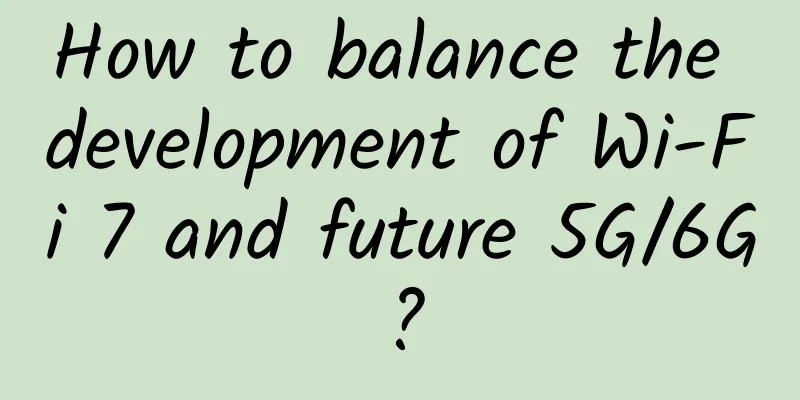How to balance the development of Wi-Fi 7 and future 5G/6G?

|
As society progresses, people's demand for information technology continues to increase. At present, new technologies such as the Internet, big data, cloud computing, artificial intelligence, and blockchain are undergoing profound evolution, and the digitalization, intelligence, and green transformation of industries are accelerating. The smart industry and digital economy are booming, greatly changing the way global resource allocation, industrial development models, and people's lifestyles. As technologies that provide basic information and communication network access service capabilities, Wi-Fi 7, 5G, and even future 6G technologies are also expanding new goals and application scenarios to adapt to the new requirements of industrial development changes. Wi-Fi 7 is comingWi-Fi technology is a wireless access technology based on a series of standard protocols under the IEEE 802.11 system. It has evolved from simply solving the terminal wireless access needs in the early days to being able to meet the needs of a large number of terminal connections, simple authentication, and high-speed applications in different scenarios such as homes and supermarkets. The latest generation of Wi Fi 7 technology has formulated the D1.5 draft in 2022, and plans to release the official version D5.0 in 2024. With the goal of supporting higher speeds, more access terminals, and higher resource utilization, Wi-Fi 7 introduces the 6GHz frequency band based on the previous generation of technology, increases the maximum bandwidth from 160MHz to 320MHz, and maintains the maximum spatial stream of 8×8 MIMO (according to the latest IEEE 802.11be D3.1 draft, Wi-Fi 7 is still 8×8 MIMO), and supports 4096QAM modulation technology, thereby increasing the theoretical maximum rate of a single stream to 2.88Gbit/s, and the overall theoretical throughput of the device reaches 23.06Gbit/s (8×8 MIMO). At the same time, in order to further improve resource utilization and device throughput, Wi-Fi 7 introduces multi-link transmission technology (MLO), which enables terminal devices to transmit data across multiple frequency bands at the same time. This can be understood as the user's mobile terminal being able to connect to the router's 2.4GHz, 5GHz, and even 6GHz bands at the same time, and automatically switch channels according to the wireless environment (such as interference, resource occupancy, etc.), comprehensively improving the user experience. For example, assuming that the interference of a family's 5GHz channel is relatively small, a user at home is using a mobile phone to connect to the 5GHz channel to play games. At this time, other users at home suddenly start to download files using the 5GHz channel, causing the 5GHz band resources to be tight. Then the mobile phone of the user playing the game will automatically switch to the 2.4GHz or 6GHz band according to the network conditions to ensure service latency and effective data transmission; when other users have finished downloading files, the mobile phone of the user playing the game will automatically switch back to the 5GHz band with less interference to ensure user experience. 5G is fully applied and 6G research and development is launched3GPP has developed 5G wireless communication standards to promote the industry to bring high-speed, high-reliability, and low-latency network connections to users. The main application scenarios of 5G include enhanced mobile broadband (eMBB), ultra-high reliability and low-latency communication (uRLLC), and massive machine-type communication (mMTC). It is the preferred mobile network for applications such as smart cities, smart medical care, smart logistics, and industrial Internet. eMBB guarantees mobile broadband speeds in the gigabit range and higher data bandwidth; uRLLC ensures ultra-high reliability and low-latency communication of less than 4 milliseconds; mMTC supports large-scale device connections in IoT applications. At present, 5G speeds are constantly increasing, and some operators can provide transmission rates of up to 10Gbit/s; latency continues to decrease and has dropped to less than 1 millisecond; new frequency bands are constantly being applied, such as C-band and millimeter wave bands, which can provide more bandwidth and better performance. By the end of May 2023, my country has built a total of 2.844 million 5G base stations, and the number of mobile IoT terminal users has exceeded 2.05 billion, fully assisting the industry's digital transformation. 6G technology, as the future evolution direction of wireless mobile communication technology, is still far away for the general public, but the start button of 6G technology has been pressed. From June 12 to 22, 2023, the 44th meeting of the 5D Working Group of the International Telecommunication Union Radiocommunication Sector (ITU-R WP5D) was held in Geneva, Switzerland, and the "Recommendation on the Framework and Overall Objectives of IMT for 2030 and Beyond" (hereinafter referred to as the "Recommendation") was released. As a 6G programmatic document, the "Recommendation" brings together the global 6G vision consensus, describes 6G goals and trends, and proposes typical scenarios and capability indicator systems for 6G. The "Recommendation" clearly defines the six major scenarios of 6G networks as immersive communication, ultra-large-scale connection, extremely high reliability and low latency, integration of artificial intelligence and communication, integration of perception and communication, and ubiquitous connection. The "Recommendation" defines 15 key capability indicators of 6G, which is an enhancement and dimensional expansion of the key capabilities of 5G. Among them, 9 capabilities are enhancements to 5G capabilities, including peak rate, user experience rate, spectrum efficiency, regional traffic, connection density, mobility, latency, reliability, security, privacy and elasticity performance indicators; 6 new capabilities include coverage capability, perception-related capabilities, AI-related capabilities, sustainability, interoperability, and positioning accuracy. It can be said that 6G technology is anchored to meet the various communication needs of people in the future digital society under ubiquitous intelligent connection. Wi-Fi 7 will complement 5G/6GFrom the perspective of future technological development, although both Wi-Fi 7 and 5G/6G support larger bandwidth, more access terminals, and lower latency, and both improve performance through increasingly advanced multiple-input multiple-output (MIMO) technology and wider spectrum bandwidth, and there is indeed a certain degree of competition between the two in terms of spectrum resource competition and network construction investment by communication operators; but in fact, there are significant differences in the application scenarios and user communication needs anchored by Wi-Fi 7 and 5G/6G technologies, and the technical and application advantages of the two in their respective target scenarios are also quite obvious. In the future, the two technologies will coexist for a long time, and unlike previous generations of wireless technologies, it is no longer an "either-or" choice. The main goal of Wi-Fi 7 is to provide terminal wireless broadband access in fixed indoor areas. Its essence is to provide higher, more stable and reliable access rates for more terminals. In addition, Wi-Fi technology currently still mainly considers the roaming of terminals between different access points in the domain, and does not yet involve the mobility switching of access terminals between different domains. The typical application scenarios of Wi-Fi 7 are WLAN networks in supermarkets, airports, stations, theaters, stadiums, and factories, especially home broadband networks for mass users. Wi-Fi technology can provide low-cost high-speed access solutions. 5G/6G technology is to solve the problem of wireless broadband access under mobility, especially for the future 6G network. Its main application scenarios include: industry applications with high reliability and deterministic latency, such as smart factories, smart medical care, smart mines, smart ports, etc.; low-latency and ultra-large bandwidth services for applications such as the metaverse and virtual reality; high-speed mobile scenarios such as high-speed rail, airplanes, and cars to meet relatively stable and high-bandwidth access requirements; high-density and ultra-large-scale terminal access requirements for scenarios of the Internet of Everything; and ubiquitous interconnection requirements for the integration of the earth and the sky in the entire aviation, aerospace, navigation, and land areas. The goal of the 6G network is to provide a data transmission rate of 1Tbit/s, and the goal of Wi-Fi 7 is to reach a peak rate of 46Gbit/s. It should be noted that these target peak rates correspond to specific coverage areas. The service range of a Wi-Fi hotspot may be only 50 meters indoors and 300 meters outdoors. When multiple hotspots are networked, coverage of medium-sized areas such as supermarkets and airports can be achieved; while the service range of cellular networks ranges from 300 meters in small communities to tens of kilometers in large communities, and within the overall coverage of the 6G network, devices can move freely and business services are uninterrupted. In addition, the goal of 6G is to provide global coverage through non-terrestrial and satellite networks, thereby achieving a coverage scale of 100 kilometers. As the most promising new wireless technologies in the future, Wi-Fi 7 and 6G have their advantages and disadvantages in different application scenarios. If you want to achieve wide coverage, high speed and free movement over long distances, 6G is a better choice; if you need to achieve higher download speeds and maintain lower power consumption in small spaces such as office buildings or homes, Wi-Fi 7 may be a better choice. For ordinary users' home application scenarios, Wi-Fi 7 is also a better choice from the perspective of construction and use costs. Of course, as the access part, Wi-Fi 7 and 6G networks can be interconnected with various edge cloud resources and AI computing resources through smart metropolitan area networks in the future, making full use of and exerting the global capabilities of the computing network. ConclusionJudging from the current technological progress, Wi-Fi 7 will arrive earlier than 6G, but all parties in the industry still need to do a lot of work to promote the popularization of Wi-Fi 7 as soon as possible. First of all, in terms of chips, although Qualcomm, MediaTek and other manufacturers have launched Wi-Fi 7 chip solutions in 2022, there are still few terminals that support Wi-Fi 7, and the expected time to market may lag behind. Therefore, all parties in the industry need to work together to promote the pilot and demonstration applications of Wi-Fi 7. At the same time, in terms of frequency band allocation, the second half of the domestic 6GHz (6425-7125MHz) has been allocated to 5G/6G systems, while the 500MHz band of 5925-6425MHz is still unclear. It is hoped that it can be divided into unlicensed bands for Wi-Fi 7 to use in the future, so as to ensure continuous 320MHz spectrum resources and provide users with relatively low-cost wireless broadband access services. |
<<: What Internet speed do smart homes need?
>>: The significance of optimizing the supply chain network design of enterprises
Recommend
edgeNAT Anniversary Sale 40% off, Hong Kong/Korea/US Data Centers Available
edgeNAT launched its first anniversary celebratio...
Wi-Fi 6 Column | How to build university networks in the 5G era (Part 1)
What changes will Wi-Fi 6 and 5G bring to the con...
spinservers: $69/month - 2*E5-2630Lv2, 64G memory, 1.6TB SSD hard drive, 1Gbps bandwidth, unlimited traffic
spinservers has released a special promotional US...
The story of spectrum: Gigabit is just the beginning
At the end of 4G development, the most advanced m...
The WiFi at home is stuck again. Who is using it for free? Here are 4 tips to make freeloaders cry!
The Wi-Fi at home is stuck again. Who is using it...
Is it necessary to upgrade from 4G to 5G mobile phone now?
As 5G network coverage continues to expand rapidl...
What does NB-IoT need to do to transform from the world's best 2G network to the world's best IoT network?
At the recent Global Terminal Summit, China Mobil...
Innovation empowers and builds the foundation for the future-"2021 China IPv6 Innovation and Development Conference" was held in Beijing
In order to implement the deployment requirements...
Edgevirt: $9/half year-1GB/25GB/5TB/10Gbps bandwidth/Seattle data center
Edgevirt is a foreign hosting company established...
Driving innovation and unleashing the unlimited potential of fiber optic LAN
It’s no secret that there are hard limits associa...
Effective Ways to Protect SIP Connections
Session Initiation Protocol (SIP) is the underlyi...
Network security knowledge: View the user license agreement
It is very necessary to understand the user licen...
What is Bluetooth Low Energy?
Bluetooth Low Energy is a new Bluetooth wireless ...
RackNerd: $39/month-E5-2690/4GB/120GB/5TB/San Jose & Seattle & Dallas, etc.
The tribe has shared a lot of cheap RackNerd VPS ...
New data transmission system developed: 10 times faster than USB
A new data-transfer system is here that's 10 ...









